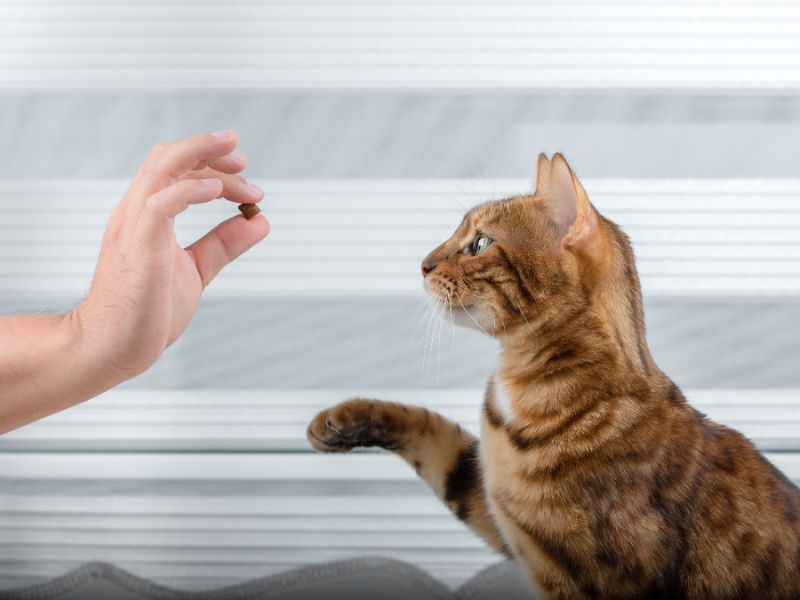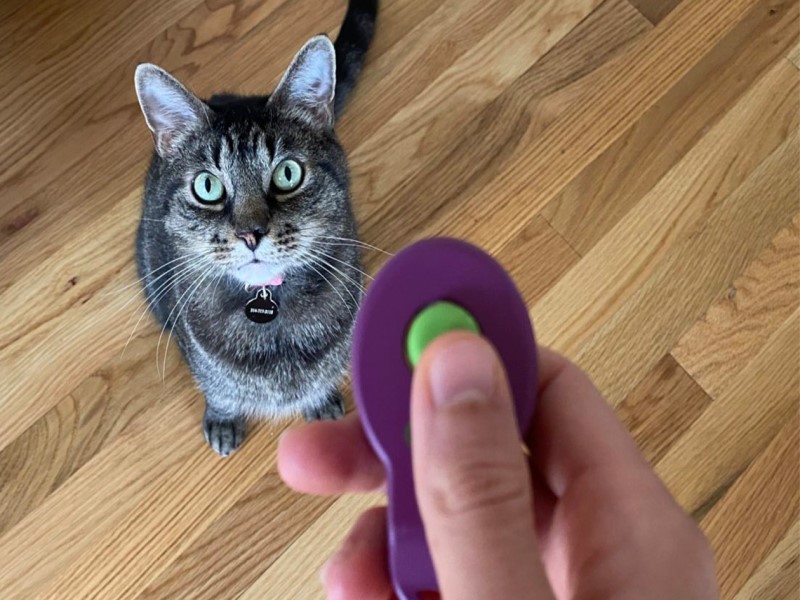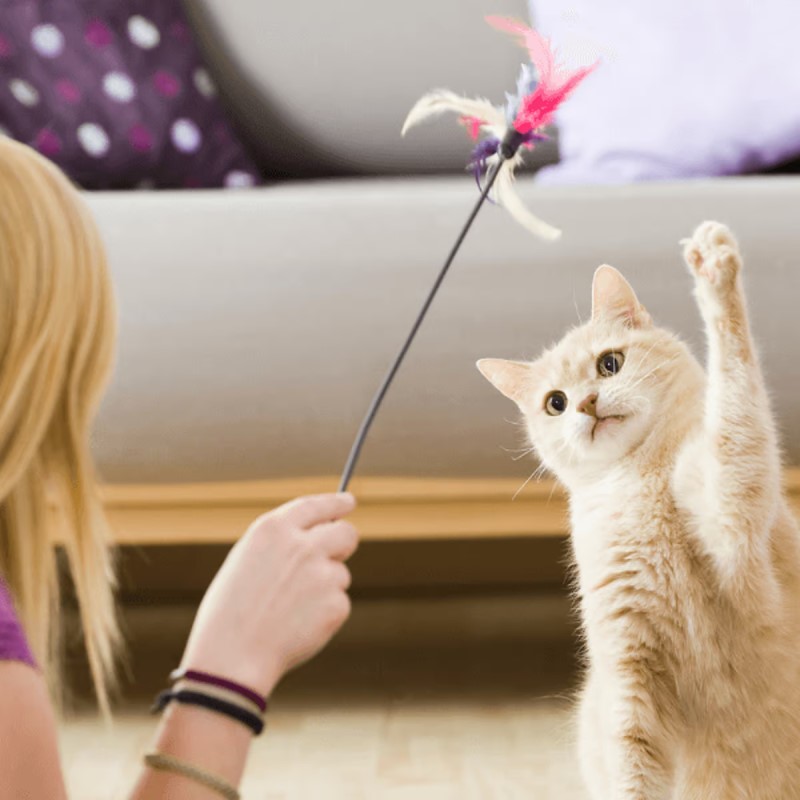The concept of “kitty training” may sound absurd to some. As everyone knows, felines are entirely unteachable. Wrong! Training kittens correctly is just as crucial as providing them with the finest cat food. Like puppies can be taught basic commands, kittens can also be taught to do so. Your cats can be trained to avoid annoying, dangerous, or otherwise harmful activities.
Training your kitten at a young age will help establish positive behaviors that will make them better companions in their lives. Many more helpful suggestions may be found in Canvas Personalized‘s best kitten training tips list.
Top 10 Useful Cat Training Tips You Should Consider
1. Provide Lots Of Rewards
When educating your kitten, cat food rewards and toys might be effective. Identifying which goodies (such as a ball, a scratch post, a meal, praise, etc.) appeal to your cat is the first step in training after socializing your kitten with people and other animals.
With the correct treat to their predatory instincts, positive reinforcement can be used to teach your cat. Using verbal cues and affirmations with a desirable reward can help you train your kitten to behave in a seductive manner.

Practical kitten obedience training with treats entails the following guidelines:
Requirements before eating
Work on obedience training your kitten’s new habits in the minutes before each feeding. Kittens and cats are more amenable to training when they are hungry. Cats shouldn’t ever be denied food. One skill is: it would be best to use mealtimes to keep your kitten’s attention and make her treats more effective.
Put away all interruptions while teaching
When your cats are young, distractions like the TV or the audio background noise can cause them to lose interest in you. Wherever feasible, find a quiet area in your house to begin training your kitten.
Limit instruction time as much as possible
Unlike dogs, cats have a shorter time to get good behavior when trained. Thus, minimize your cat’s training sessions to no more than 15 minutes. Cats have a short attention span and soon become bored. Take care that she isn’t bored during your kitten’s training sessions.
Don’t switch gears midway
Like dogs, you should maintain a consistent pattern of gestures and hints. Don’t be hesitant to try new kinds of treats if you want to keep things interesting for your tiny learner.
Get better at just one skill at a time
Teaching cats a new ability one at a time is the most efficient method. If you try to train your kitten too quickly, you will overwhelm it and make the process more difficult and ineffective. One should never move on to a new skill until one has mastered it.
Just chill out
Treating requires patience. Wait until you have your kitten’s focus before you begin playing. If your cats get distracted when trained, you may need to put the session on hold.
2. Train You Cat By Using Clickers

Kittens and adult cats respond well to clicker training. There’s some evidence that using a clicker train can assist shelter cats in maintaining concentration. Clicker training has improved shelter cats’ chances of getting adopted. Follow these instructions to start using a clicker with cats in your home workouts:
- Just by clicking, you may show your appreciation
Click and give your cats a tasty treat as soon as they do what you want. The click and subsequent reward will show your feline that it is doing well.
- Repeat
Kittens are no different from any other student in that kittens learn best via repetition. Developing a good clicker association with your kitten is essential, so use it regularly and always follow it up with a treat.
- Just remember to keep it brief
Sessions using a clicker trainer should be brief, as with any instruction. Too much repetition with the clicker will have the opposite impact on your kittens.
3. Prevent Being Punished
You’ll need an innovative approach to proper training if your cat has bad habits of climbing up on counters. Cats and kittens aren’t the kinds of animals who take discipline well. Instead, it’s better to devise a plan to avoid unwelcome actions. These methods can help you get your kitty to quit doing things like linking the target with something negative.

Use your imagination to find effective methods of discouraging your cat from attempting to use the counter as a scratching post. You may stop your cat from jumping up on the counter by taping it down or putting something on it that it hates. Your cat will eventually stop leaping up on the counter or scratching posts, at which point you can get rid of the obstacle. Popular tips for training a kitten here are that incentives should continue.
If you want to halt a bad habit, you should always look for chances for positive reinforcement. If you don’t want your cat jumps on the counter, you can train your cat to use a cat tree by placing treats on it. In other words, doing this will strengthen the desirable habit and supplant the undesirable one.
4. Get Your Cat Used To Be Handled
A lot of physical interaction is involved in cat care to prevent common health problems. We’ll start with the basics of personal hygiene for your pet.
Your cat will need regular grooming throughout its life, including brushing, nail trimming, and removal of mats and dirt from the hair. If you start socializing with them early, performing these duties on all body parts as your kitty matures will be much easier.
Noticeable kitten tips training session: Spend quality time holding your cat and observing its fur, eyes, and ears. Look inside the mouth of your kitten. When you do this regularly, your cats will become accustomed to it and be more willing to let you and your doctor perform a hands-on exam.
5. Instruct On How To Play Properly

A kitten’s natural instinct is to stalk and pounce on everything that moves at the first time. Even your feet and hands are not immune to this! You may find this endearing (or at least bearable) when your kitten is tiny, but it could become a significant issue as he or she matures.
You should use high-quality toys to have fun with your highly intelligent kittens. The surplus energy of your kitten can be expended safely with the help of a toy mouse or a teaser wand (a feather on a string at the end of a pole).
Reward her to encourage your kitten to continue playing with these toys. Take care to steer your cat away from harsh or violent play and toward more appropriate pursuits.
6. Start Early With Socializing Your Pets
When young, animals are more open to experiencing new environments, people, and things. Kittens are most impressionable between three and nine weeks, making this time period ideal for socialization.
If you get a kitten before it’s nine weeks old, you’ll have a golden opportunity to socialize it. At nine weeks old, a kitten is still far more receptive to new situations than an adult cat will be.
Take care that all your kitten’s new experiences with strangers are pleasant. Ask your visitors if they’d like to play with your kitten. Put some delectable treats in the hands of individuals who engage positively to boost their mood. Find a vet who can keep your kitten’s visit to the clinic to a minimum of stress and use tasty treats to make the trip enjoyable for your cat.
If you take these precautions, your kitten will grow up to be a sociable, outgoing adult rather than a fearful, reclusive kitty who runs and hides at the sight of strangers.
7. Get Your Kitten Used To Travel In A Pet Carrier

A pet carrier is necessary if you plan on taking your kitten on the go. Whether you’re just going across town to the vet or hitting the open road for a cross-country adventure, keeping your kitty confined is the best way to ensure its safety. The fear of being enclosed in a cat carrier is a significant deterrent for many other cats.
During the trip, they may become anxious and start crying or meowing. So one of the best kitten training tips in this situation is introducing your kitten to the carrier at an early age. This can make travel less stressful for both of you.
Leave your kitten in its carrier in the living room while you are out. It would be best if you threw in some goodies or cute toys to get your kitten to explore the carrier. To further reinforce the good memories associated with the carrier, you might choose to feed your kitten there a few times. Your kitten may become more comfortable with the carrier if you introduce it to it gradually.
8. Name-Recognition Kitten Training

Having a cat come when called is a tremendous accomplishment, but obedience training your kitten may be challenging. Choose a short, memorable name for your pet, and use it frequently, responding to your kitten with a pleased “yes” or click cues (if you’re using a clicker) and a portion of tasty cat food reward. Depending on the pet, it may take several weeks or months, but kittens usually quickly pick up new skills.
9. Teaching It To Follow Commands
Kittens may be educated to respond to commands in much the same way as they can learn their name. It will take time and perseverance, but the reward is worth it when you and your kitty can finally cuddle up together.
Starting with simple commands like “sit” to your kitten makes the other tasks pretty helpful (which means they will stand up on their hind feet). As soon as your kitten sits, use more kind words or click cues to reinforce the positive behavior and give her a treat.
10. Litter Train for Indoor Cats

Make sure your new kitten sees the litter box as soon as possible when they arrive home. Just place them in the litter box and give them time to adjust. Immediately after meals and naps, place your kitten in the litter box and reward it with a favorite treat if it uses the litter box to eliminate waste.
Expect a few weeks for this to happen, but most kittens are naturally smart and can learn quickly once they start. They’ll pick it up soon with encouragement and time spent exploring the possibilities.
What To Do When Your Cat Misbehaves?
Be patient and happy. Your cat’s unwanted behavior could be due to several factors, including stress over recent changes at home, a health issue, or simply a lack of self-awareness. Your cat’s bad behaviors probably have nothing to do with her being offended or spiteful against you, despite what you might assume.

Instead of penalizing her, redirecting the behavior is more likely to get her back on track. If you threaten her, she may respond to you with defensive behavior, which might increase her stress and bad behavior like scratching and biting.
In addition to harming your relationship, her fear of you can have a negative impact on her confidence in you. Nonetheless, she must be made aware of inappropriate conduct. Bad behavior can be discouraged by associating it with a negative consequence.
Perfume and citrus, for example, are among the smells that can make cats sick. To prevent your kitty from entering restricted areas, you can use cotton balls soaked in these scents to deter her. It’s important to always reward your cat’s good behavior with praise. If you reward her whenever she does anything right, she’ll eventually start associating the two.
Kitten Training Tips FAQs
1. Does it take much effort to train your kitten?
However, contrary to popular common misconception, cats are highly intelligent and can be taught a wide range of behaviors. Training your kitten should start as soon as possible if you want her to feel welcome in the new home.
2. How can I train a kitten quickly and easily?
Cats are often bored and require training sessions short. Don’t try to train your cat to all the simple commands at once; concentrate on getting her to master one at a time. So that she learns to obey you wherever, it’s one of the great kitten training tips to practice the commands in various house rooms.
3. How does one become best friends with a kitten?
One of the best tips for training a kitten to bond with a kitten is to pick it up and cuddle it. Start holding your kitten for brief periods of time and letting her go before she starts to wriggle if she isn’t used to being held. To make her more at ease, you should repeat this numerous times daily.
4. What are some techniques for socializing a kitten to be well-behaved?
Petting and light touching can help your cat learn to become accustomed to being handled by humans. Thus the best kitten training tips are to be patient when introducing your kitten to other pets; keep it isolated until it has learned to use the litter box and received all its vaccinations. Introduce people slowly and carefully under strict supervision, and keep an eye on everything.
5. What are the upsides to training kittens?
While training a kitten isn’t easy, the benefits make it worthwhile. You and your new cat can spend quality time together learning each other’s personalities and quirks while undergoing training. On top of that, by keeping cats mentally active, you’re doing something beneficial for their longevity and well-being.
You can do a lot more to improve your mood and the attitude of those around you if you start training your kitten as soon as possible and reinforce positive behaviors and teach them cute skills. It will be challenging for first-time cat owners to learn how to properly train their pets.
>>> Read more:
How to Teach a Cat to Fetch in 6 Easy Steps?
Canvas Personalized hopes you’ve gained knowledge and confidence in cat care from these kitten training tips above. Putting your whole heart into pet training will make a difference in shaping positive behaviors for your pet, even if initially challenging. You and your kitten will develop a deeper emotional connection during this period.










